- Home
- Markets and prices
- Cereals and oilseeds markets - Supply and demand - Crop development
Crop development
April 2024
The interactive tool at the bottom of this page helps show the condition and growth stages of different crops across GB. The chart is split into regions and uses colours to show different conditions. You can also use the bottom chart to see growth stages of cereals or oilseeds.
Overview
The UK’s growing cereals and oilseeds are more varied in their stage of development than usual for the time of year.
In April, there was less rainfall than in preceding months in most regions, giving hope to some growers of longer drier spells. But the intermittent showers still prevented some saturated soils from drying sufficiently, offering some regions with ‘false starts’ to the spring fieldwork. While winter crop conditions in these areas are better than in late March, they continue to struggle.
In other regions, which either received less rainfall or have better draining soils, spring fieldwork has been progressing well and crop conditions have improved noticeably since last month.
The information in this report was captured up to Tuesday 30 April 2024 for AHDB by The Andersons Centre. Key differences between crops are explored below, with more detail in the full report.
Crop condition definitions
Crop condition was assessed using the USDA approach. This classifies crops into one of five categories, from very poor through to excellent (see details below). The values are given as the percentage of the GB crop area for that crop that falls in each of the categories – regional condition scores are available on the crop reporting dashboard at the bottom of this page.
- Very Poor - Extreme degree of loss to yield potential, complete or near crop failure.
- Poor - Heavy degree of loss to yield potential, which can be caused by excess soil moisture, drought, disease, etc.
- Fair - Less than normal crop condition. Yield loss is a possibility, but the extent is unknown.
- Good - Yield prospects are normal. Moisture levels are adequate and disease, insect damage, and weed pressures are minor.
- Excellent - Yield prospects are above normal. Crops are experiencing little or no stress. Disease, insect damage, and weed pressures are insignificant.
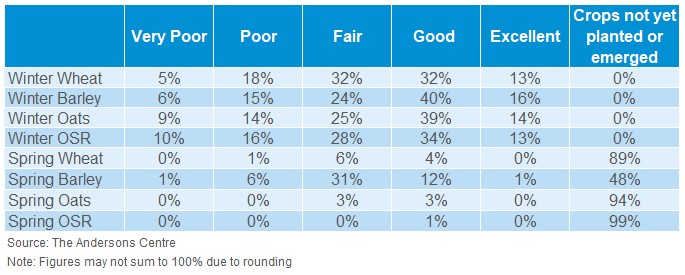
From March 2024, the survey work was undertaken by The Andersons Centre, while for previous years the survey work was undertaken by RSK ADAS; please take this into consideration when comparing to historical figures.
Wheat
Nationally, the wheat crop is in one of its poorest states in recent years at this time of year. Winter wheat has suffered from an unsatisfactory crop establishment and overwintered in very wet soil conditions. These have led to root damage and some plant rot. Many fields are very gappy, whilst others were either never drilled or have been written off. The worst crops are in the Midland areas stretching from Gloucestershire to Lincolnshire and parts of East Anglia and Yorkshire. In other parts of the UK, particularly the south of England north of England and Scotland winter wheat crops are in better condition. Crops on free draining chalks and sandy soils are reasonable to good.
Nationally, 45% of winter wheat is rated as in a good or excellent condition. This is up from the end of March (34%) but still significantly below last April’s 88%.
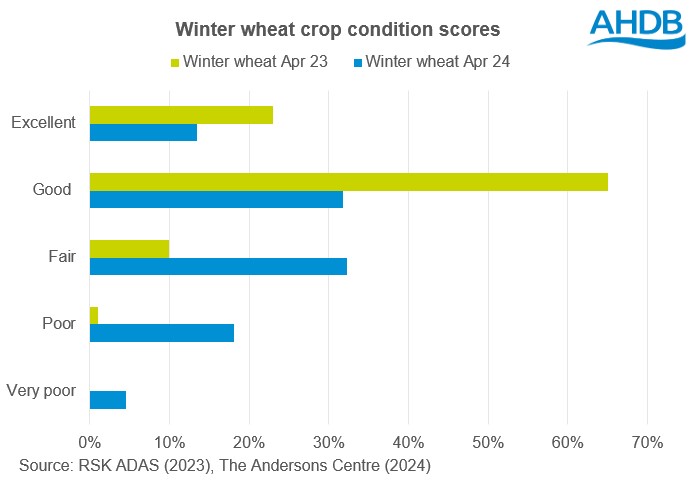
Some very late drilling of usually winter varieties, as well as spring wheat crops, has taken place in April and these crops are now emerging. Planting winter wheat varieties this late is very high risk as without enough cold weather, crops won’t be able to progress beyond tillering this year. The vast majority of spring sown wheat was still to emerge at the end of April.
Winter barley
Prospects for the winter barley crop are generally a tale of two halves. The good free draining land and/or where crops were drilled in September and established well, offer good yield potential. These crops look well, are forward, reasonably clean and now have the flag leaf emerging.
But those on heavier soils, particularly the areas worst affected by the rainfall events in say the Midlands and North, are not so good. These crops are really variable and at all growth stages; some areas died or struggled in the wet. Even where they have picked up, these winter barley crops have lost tillers. As a result, whilst from the road they look visibly better, when you get in those crops, they are relatively thin and focused on the main tiller which has bolted. This will inevitably mean much lower yield prospects.
In total 56% of winter barley is rated as in a good or excellent condition, a notable improvement from the 38% in late-March. However, this is still well below the 90% rated good to excellent at this point a year ago.
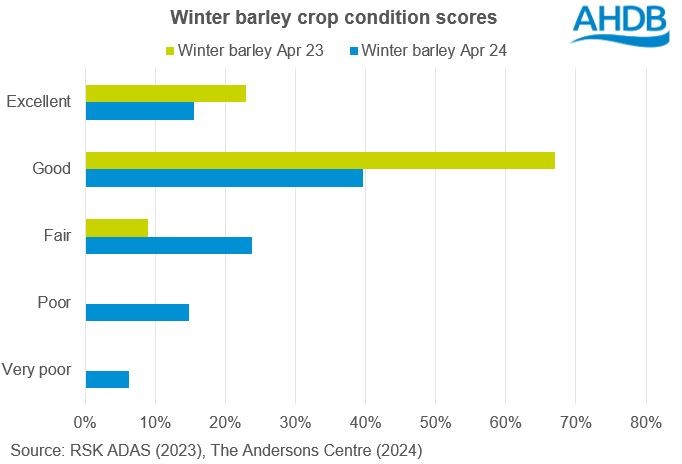
Spring barley
Longer periods of dry weather between the showers in April has allowed most growers to drill their spring barley seed. Most will have wanted to have finished by the end of April, but there are still empty fields waiting to see the drill. This year, the range of drilling dates and crop conditions is large.
Well-drilled late barley is looking far better than barley drilled early in poor soil conditions or where it then had further heavy rain post drilling. A few parts of the Eastern coast though, do have some excellent looking January drilled spring barley. Early drilled spring barley is well established now, having passed its 3-leaf stage.
The clock is now ticking, with only a few days left to drill spring barley in most of the UK. An estimated 48% of the crop has yet to be planted or emerge (a breakdown is not available). This is down from the 67% at this stage last year but still well above the 19% at the end of April 2022.
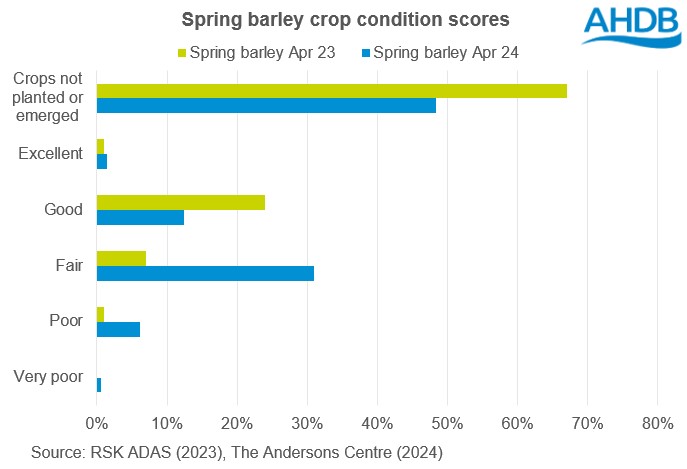
Oats
In total 53% of the winter oat crop is rated as good or excellent, up from 37% in late-March. Oats are a resilient crop and the winter crops, provided they established well, have stood the test of the wet conditions reasonably well. That said, they are not in as good a condition as we would like for this time of year e.g. last year 81% was rated good or excellent. They are exceptionally varied with the usual variance in height and colour across the field that oats often show, but even more so this year.
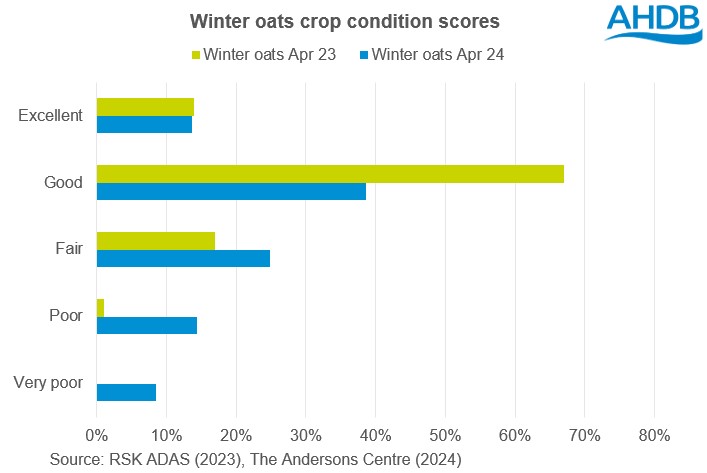
Spring oats, in the main, have all been planted by now with a few isolated fields left to establish. What little spring oats have emerged are doing well, but the majority is yet to get going.
Oilseed rape
As winter oilseed rape (OSR) in the majority of the UK comes into flower, the patchy fields, and the uneven crops become clearer than ever. Pest pressure and poor root conditions remain issues. Overall, only 47% of the winter oilseed rape crop is rated as in good or excellent condition. This represents an improvement from late March (31%) but is still well below the 66% with the same rating at the end of April 2023.
It’s too early to comment on spring oilseed rape, with most not yet emerged.
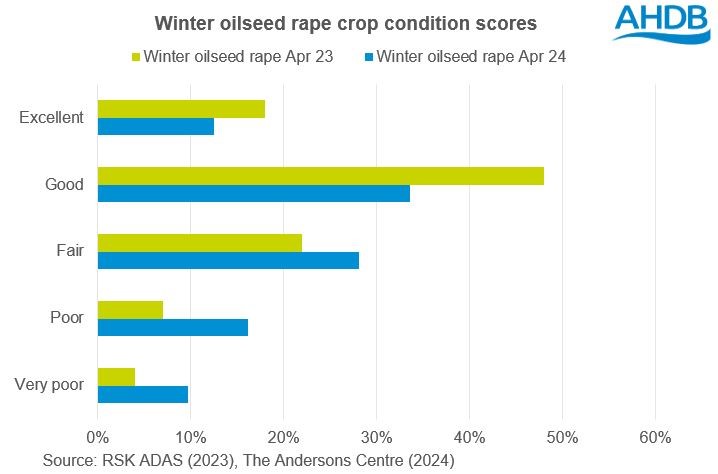
How to use the dashboard
- Use the drop down menu at the top of the first chart to view the crop conditions of a particular crop in each region.
- Use the drop down menus at the top of the second chart to view the percentage of a crop at each growth stage. The drop down menus can also be used to show the information for a particular region.
Historical crop development reports
While AHDB seeks to ensure that the information contained on this webpage is accurate at the time of publication, no warranty is given in respect of the information and data provided. You are responsible for how you use the information. To the maximum extent permitted by law, AHDB accepts no liability for loss, damage or injury howsoever caused or suffered (including that caused by negligence) directly or indirectly in relation to the information or data provided in this publication.
All intellectual property rights in the information and data on this webpage belong to or are licensed by AHDB. You are authorised to use such information for your internal business purposes only and you must not provide this information to any other third parties, including further publication of the information, or for commercial gain in any way whatsoever without the prior written permission of AHDB for each third party disclosure, publication or commercial arrangement. For more information, please see our Terms of Use and Privacy Notice or contact the Director of Corporate Affairs at info@ahdb.org.uk © Agriculture and Horticulture Development Board. All rights reserved.

